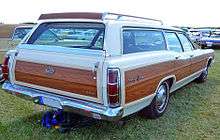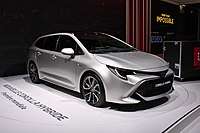Station wagon
A station wagon, also called an estate car, estate or wagon, is a car body style which has a two-box design, a large cargo area and a rear tailgate that is hinged to open for access to the cargo area. The body style is similar to a hatchback car, but station wagons are longer and are more likely to have the roof-line extended to the rear of the vehicle body[1] (resulting in a vertical rear surface to the car) to provide ample space for luggage and small cargo.
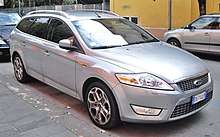
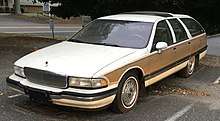
The first station wagons, produced in the United States around 1910, were wood-bodied conversions of an existing passenger car. During the 1930s, car manufacturers in the United States, United Kingdom, and France began to produce similarly-styled models, and by the 1950s the wood rear bodywork had been replaced by an all-steel body. Station wagon and estate models sold well from the 1950s to the 1970s, after which sales declined somewhat as minivans and SUVs have increased in popularity.
Name
Reflecting the original purpose of transporting people and luggage between country estates and railway/railroad stations,[2] the body style is called an "estate car" or "estate" in British English, "station wagon" in American English, and generally one of these two variants in the rest of the English-speaking world.
In the United States, early models with exposed wooden bodies became known as woodies.[3]
In Germany, the term "Kombi" is used, short for Kombinationskraftwagen ("combination motor vehicle").
Station wagons have been marketed using the French term "break de chasse" (sometimes abbreviated to "break"), which translates as "hunting break", due to shared ancestry with the shooting-brake body style.
Manufacturers may designate station wagons across various model lines with a proprietary nameplate. Examples include "Avant", "Caravan", "Kombi", "Sports Tourer", "Sports Wagon, "Tourer", "Touring" and "Variant".
Design characteristics
Comparison with hatchbacks
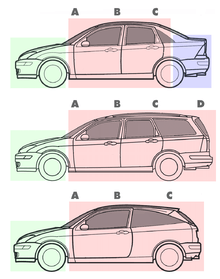
Station wagons and hatchbacks have in common a two-box design configuration, a shared interior volume for passengers and cargo[4][5] and a rear door (often called a tailgate in the case of a wagon) that is hinged at roof level.[6][7][8] Folding rear seats (in order to create a larger space for cargo) are also common on both station wagons and hatchbacks.[9]
Distinguishing features between hatchbacks and station wagons/estates are:
- D-pillar: Station wagons and estates are more likely to have a D-pillar (hatchbacks and station wagons both have A-, B- and C-pillars).
- Cargo volume: Station wagon and estate designs place a priority upon passenger and cargo volume — with windows beside the cargo space. Of the two body styles, a station wagon roof (viewed in profile) more likely extends to the very rearmost of the vehicle, enclosing a full-height cargo volume[5] — a hatchback roof (especially a liftback roof) might more likely rake down steeply behind the C-Pillar, prioritizing style[1] over interior volume, with shorter rear overhang and with smaller windows (or no windows) aside the cargo volume.
Other differences are more variable and can potentially include:
- Cargo floor contour: for maximum cargo capacity, a station wagon or estate often has a fold-flat floor, whereas a hatchback is more likely to have a cargo floor with a pronounced contour.
- Seating: Station wagons and estates may have two or three rows of seats, while hatchbacks typically only have one or two.[4] The rearmost row of seating in a station wagon is often located in the cargo area and can be either front-facing or rear-facing.
- Rear suspension: A station wagon or estate may include reconfigured rear suspension for additional load capacity[1] and to minimize intrusion in the cargo volume.
- Rear Door: Hatchbacks usually feature a top-hinged lift-gate for cargo access, with variations ranging from a two-part lift-gate to a complex tail gate that can function either as a full tail gate or as a trunk/boot lid. Station wagons and estates have also been equipped with numerous tailgate configurations. Hatchbacks may be called Liftbacks when the opening area is very sloped and the door is lifted up to open.[4] A design director from General Motors has described the difference as "Where you break the roofline, at what angle, defines the spirit of the vehicle", he said. "You could have a 90-degree break in the back and have a station wagon."[10]
It has become common for station wagons and estates to use a shared platform with other body styles, resulting in many shared components (such as chassis, engine, transmission, bodywork forward of the A-pillar, interior features and optional features) being used for the wagon, sedan and hatchback variants of the model range.[11]
Tail gate designs
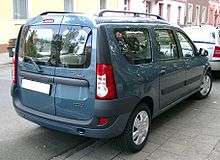
Many modern station wagons and estates have an upward-swinging, full-width, full-height rear door supported on gas springs — often where the rear window can swing up independently. A variety of other designs have been employed in the past.
Split gate
The earliest common style was an upward-swinging window combined with a downward swinging tailgate. Both were manually operated. This configuration generally prevailed from the earliest origins of the wagon body style in the 1920s through the 1940s. It remained in use through to 1960 on several models offered by Ford, including the 1957-58 Del Rio two-door wagon. This style was later adopted on aftermarket camper shells for pickup trucks and coupé utility cars, as both already types of vehicle often had a bottom half tailgate as an original feature.
Retractable window
In the early 1950s, tailgates with hand-cranked roll-down rear windows began to appear. Later in the decade, electric power was applied to the tailgate window—it could be operated from the driver's seat, as well as by the keyhole in the rear door. By the early 1960s, this arrangement was common on both full-size and compact wagons.
- Side hinge: A side hinged tailgate that opened like a door was offered on some three-seat station wagons to make it easier for the back row passengers to enter and exit their rear-facing seats. This was later supplanted by the dual-hinged tailgate.
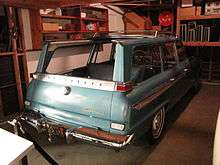
Retractable roof
These have a retractable rear roof section as well as a conventional rear tailgate which folded down to carry tall objects that would not fit otherwise. The configuration appeared on the Studebaker Wagonaire station wagon and 2003 GMC Envoy XUV.
Dual and tri-operating gates
Ford's full-size station wagons for the United States market introduced a system marketed as "Magic Doorgate" in 1966 — a conventional tailgate with retracting rear glass, where the tailgate could either fold down or pivot open on a side hinge — with the rear window retracted in either case. Competitors marketed their versions as a Drop and Swing or Dual Action Tailgate.[11] For 1969, Ford incorporated a design that allowed the rear glass to remain up or down when the door pivoted open on its side hinge, marketing the system, which had been engineered by Donald N. Frey[12] as the "Three-Way Magic Doorgate". Similar configurations became the standard on full-size and intermediate station wagons from GM, Ford, Chrysler, and AMC. GM added a notch in the rear bumper that acted as a step plate; to fill the gap, a small portion of bumper was attached to the door-gate. When opened as a swinging door, this part of the bumper moved away, allowing the depression in the bumper to provide a "step" to ease entry; when the gate was opened by being lowered or raised to a closed position, the chrome section remained in place making the bumper "whole".
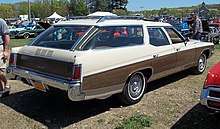
Clam shell
Full-size General Motors 1971–1976 wagons — the Chevrolet Kingswood, Townsman, Brookwood, Bel Air, Impala, and Caprice Estates; Pontiac Safari and Grand Safari; Oldsmobile Custom Cruiser, and the Buick Estate models — featured a 'clam shell' design marketed as the Glide-away tail-gate, also called a "disappearing" tailgate because when open, the tailgate was completely out of view. On the clam shell design, the rear power-operated glass slid up into the roof and the lower tailgate (with either manual or optional power operation), lowered completely below the load floor. The manual lower tailgate was counterbalanced by a torque rod similar to the torque rods used in holding a trunk lid open, requiring a 35 lb push to fully lower the gate. Raising the manual gate required a 5 lb pull via a handhold integral to the top edge of the retractable gate.[13] The power operation of both upper glass and lower tail-gate became standard equipment in later model years. Station wagons with the design featured an optional third row of forward-facing seats accessed by the rear side doors and a folding second-row seat — and could accommodate a 4 x 8' sheet of plywood with rear seats folded. The clam shell design required no increased footprint or operational area to open, allowing a user to stand at the cargo opening without impediment of a door — for example, in a closed garage. Subsequent GM full-size wagons reverted to the door-gate style for its full-size wagons.
Lift-gate
A simplified, one-piece lift-gate on smaller wagons. Subsequent generation of GM's full-size station wagons returned to the upward-lifting rear window as had been used in the 1940s.
- Swing-up window: An upward-lifting, full-height, full-width rear door, where the window on the rear door can be opened independently from the rear door itself. The window is also opened upwards and is held on pneumatic struts. The Renault Laguna II estate and Ford Taurus wagon featured this arrangement.
- Fold-up number plate: Wagons (including the Volvo Amazon wagon, early models of the Range-Rover, and the Subaru Baja) had an upward folding hinged plate attached to the lower tail-gate of the split rear door. When the tailgate was folded down, the plate hung down and remained readable. The wagon versions of the Citroen DS, variously called the Break, Familiale or Safari, had a different solution: two number plates were fitted to the tailgate at right angles to each other so one would be visible in either position.
Safety equipment
Cargo barriers may be used to prevent unsecured cargo from causing injuries in the event of sudden deceleration, collision, or a rollover.[14]
Performance models
The 1994 Audi RS2, developed in conjunction with Porsche, is considered the world's first performance station wagon.[15] Prior to this, performance models of station wagons included the 1970 Ford Falcon (XY) 'Grand Sport' pack,[16] the 1973 Chevrolet Chevelle Malibu SS-454 and the 1992 BMW M5 (E34).
Several German manufacturers have produced estate versions of high-performance models, such as the Audi RS4, Audi RS6, Mercedes-AMG C63, Mercedes-AMG E63, BMW M5 (E60/E61), Volkswagen Golf R and Volkswagen Passat R36 wagons.[17][18][19]
History
Origins
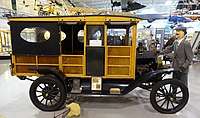
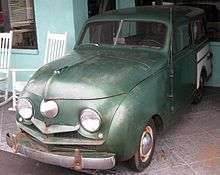
The first station wagons were built in around 1910, by independent manufacturers producing wooden custom bodies for the Ford Model T chassis.[20] They were originally called "depot hacks" because they worked around train depots as hacks (short for hackney carriage, as taxicabs were then known).[21] They also came to be known as "carryalls" and "suburbans".[20]
Eventually, car manufacturers began producing their own station wagon and estate designs. In 1923 Star (a division of Durant Motors) became the first car company to offer a station wagon assembled on its production line (using a wooden wagon body shipped in from an outside supplier).[22][23][24]
The framing of the wooden bodies was sheathed in steel and coated with tinted lacquer for protection. These wooden bodies required constant maintenance: varnishes required re-coating and expansion/contraction of the wood meant that bolts and screws required periodic re-tightening. In 1922, the Essex Closed Coach became the first mass-produced car to use a steel body (in this case, a fully enclosed sedan body style).[25] The first all-steel station wagon body was the 1935 Chevrolet Suburban.[20] As part of the overall trend in the automotive industry, wooden bodies were superseded by all-steel bodies due to their strength, cost, and durability.[26] By 1951, most station wagons were being produced with all-steel bodies.[20]
United States
1910 to 1945: woodie wagons
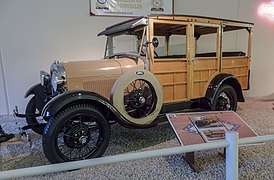

Station wagons were initially considered commercial vehicles (rather than consumer automobiles) and the framing of the early station wagons was left unsheathed, due to the commercial nature of the vehicles. The commercial vehicle status was also reflected on those vehicles' registrations, for example there were special "Suburban" license plates in Pennsylvania used well into the 1960s, long after station wagons became car-based.
Early station wagons were fixed-roof vehicles, but lacked the glass that would normally enclose the passenger compartment, and had only bench seats.[26] In lieu of glass, side curtains of canvas could be unrolled. More rigid curtains could be snapped in place to protect passengers from the elements outside. The roofs of "woodie" wagons were usually made of stretched canvas that was treated with a waterproofing dressing.
Manufacture of the wooden bodies was initially outsourced to custom body builders,[27][28] because the production of the all-wood bodies was very time-consuming. One of the first builders of wagon bodies was the Stoughton Wagon Company from Wisconsin, who begun putting custom wagon bodies on the Ford Model T chassis in 1919[26] and by 1929 the Ford Motor Company was the biggest producer of chassis' for station wagons. Since Ford owned its own hardwood forest and mills (at the Ford Iron Mountain Plant in Michigan) it began supplying the wood components for the Model A station wagon.[26] Also in 1929, J. T. Cantrell began supplying woodie bodies for Chrysler vehicles, which continued until 1931.[26]
By the 1930s, station wagons had become expensive and well-equipped vehicles.[23] When it was introduced in 1941 the Chrysler Town & Country was the most expensive car in the company's model range.
1945 to 1970: Steel-bodied station wagons
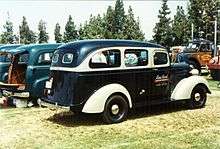
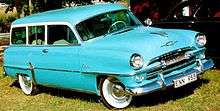
The first all-steel station wagon was the 1935 Chevrolet Suburban, which was built on the chassis of a panel truck.[20] However, most station wagons were produced with wooden bodies until after World War II.
When automobile production resumed after World War II, advances in production techniques made all-steel station wagon bodies more practical, eliminating the cost, noise, and maintenance associated with wood bodies.[29] The first mass-produced steel-bodied station wagon was the 1946 Willys Station Wagon, based on the chassis of the Jeep CJ-2A.[20][30][31] In 1947, Crosley introduced a steel-bodied station wagon version of the Crosley CC Four.
The first postwar station wagon to be based on a passenger car chassis was the 1949 Plymouth Suburban, which used a two-door body style. Several manufacturers produced steel and wooden-bodied station wagons concurrently for several years, for example Plymouth continued production of wooden bodied station wagons until 1950. The final wooden bodied station produced in the United States was the 1953 Buick Super Estate.
Station wagons experienced highest production levels in the United States from the 1950s through the 1970s.
The late 1950s through the mid-1960s was also the period of greatest variation in body styles, with models available without a B-pillar (called hardtop or pillarless models) or with a B-pillar, both in 2-door and 4-door variants.[32] The pillarless models could be expensive to produce, added wind noise, and created structural issues with body torque.[33] GM eliminated the pillarless wagon from its lineup in 1959, while AMC and Ford exited the field beginning with their 1960 and 1961 vehicles, leaving Chrysler and Dodge with the body style through the 1964 model year.
1970 to 1990: Competition from minivans
.jpg)
The popularity of the station wagon, particularly full-size station wagons, in the US was blunted by increased fuel prices caused by the 1973 oil crisis.[20][23] Then in 1983, the market for station wagons was further eroded by the Chrysler minivans, based on the K platform.[21][34] While the K platform was also used for station wagon models (such as the Plymouth Reliant and Dodge Aries), the minivan would soon eclipse them in popularity. The US CAFE standards provided an advantage to minivans (and later SUVs) over station wagons, because the minivans and SUVs were classified as trucks in the United States, and therefore subject to less stringent fuel economy and emissions regulations. Estate cars remained popular in Europe[35] and in locations where emissions and efficiency regulations did not distinguish between cars and light trucks.[36]
1990 to present: Competition from SUVs
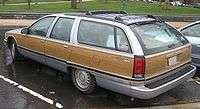
The emergence and popularity of SUVs which closely approximate the traditional station wagon / estate body style was a further blow. After struggling sales, the Chevrolet Caprice and the Buick Roadmaster, the last American full-size wagons, were discontinued in 1996. Smaller station wagons were marketed as lower priced alternatives to SUVs and minivans. Domestic wagons also remained in the Ford, Mercury, and Saturn lines, however after 2004 these compact station wagons also began to be phased out in the United States. The Ford Taurus wagon was discontinued in 2005 and the Ford Focus station wagon was discontinued in 2008. An exception to this trend was the Subaru Legacy and Subaru Outback station wagon models, which continue to be produced at the Subaru of Indiana plant. With other brands, the niche previously occupied by station wagons is now primarily filled with the similar style of Crossover SUV, which generally has a car underpinning and a wagon body.
Imported station wagons, despite remaining popular in other countries,[37] struggled in the United States. European luxury car manufacturers such as Audi, BMW, and Mercedes-Benz continued to offer station wagons in their North American product ranges (marketed using the labels "Avant", "Touring", and "Estate" respectively). However, these vehicles had fewer trim and power train levels than their sedan counterparts.[34] The Mercedes-Benz E63 AMG in Estate trim is a performance station wagon offered in the U.S. market. The station wagon variants of the smaller Mercedes-Benz C-Class line-up were dropped in 2007 and the BMW 5 Series Touring models were discontinued in 2010, due to slow sales in the United States with only 400 wagons sold in 2009.[38] In 2012, the Volvo V50 compact station wagon was withdrawn from the U.S. market due to poor sales.
The Cadillac CTS gave rise to a station wagon counterpart, the 2010 CTS Sportwagon, which defied the trend by offering almost as many trim levels as its sedan counterpart.[34] The CTS wagon, particularly in high-performance CTS-V trim, received positive reviews until it was discontinued in 2014.[39][40]
In 2011, the Toyota Prius V introduced hybrid power to the compact wagon market, but was discontinued in 2017 to streamline the Toyota hybrid lineup and focus on the RAV4 Hybrid Crossover SUV.[41]
The 2015 VW Golf Sportwagen[42] was marketed as a sub-compact station wagon in the North American market. As of 2019, Volkswagen announced the cancellation of the Sportwagen in the US market.[43]
In 2016, Volvo re-introduced a large wagon to the US market with the Volvo V90, but only by special order.[44]
Simulated wood panelling
As the wooden bodies were replaced by steel bodies from 1945 to 1953, manufacturers applied wooden decorative trim to the steel-bodied wagons, as a visual link to the previous wooden style. By the late 1950s, the wooden trim was replaced by "simulated wood" in the form of stick-on vinyl coverings.[45][46]
The Ford Country Squire is a model that was easily recognized by its simulated wood trim[47][48] and the "Squire" trim level was an available option in a few different Ford model ranges, including the Falcon Squire, Fairlane Squire, and in the 1970s the Pinto Squire. The Squire was always the highest trim level of any Ford Wagon and included the signature wood grain applique, and usually additional exterior chrome, nicer interior trim, special emblems, etc. The full-size Country Squire model was the produced in much higher quantities than the other Ford models.
Other woodie-style wagon models produced in significant numbers include the 1984-1993 Jeep Grand Wagoneer,[49][50] 1957-1991 Mercury Colony Park, 1968-1998 Chrysler Town & Country, 1970-1990 Buick Estate, 1971-1992 Oldsmobile Custom Cruiser and 1969-1972 Chevrolet Kingswood Estate.
Full-size wagons
From the 1950s to 1990s, many full-size American station wagons could be optioned with a third row of seating in the cargo area (over the rear axle) for a total of nine seats. Prior to 1956, the third row seats were forward facing.
Chrysler's 1957 models had a roof too low to permit a forward-facing seat in the cargo area, so a rear-facing seat was used for the third row.
General Motors adopted the rear-facing third row for most models during 1959-1971 and 1977–1996. However the 1964–1972 Oldsmobile Vista Cruiser and 1964–1969 Buick Sport Wagon featured raised roof-lines beginning above the second-row seat and continuing all the way to the rear tailgate, resulting in the third row of seats being forward-facing. General Motors also used forward-facing seats for the third row in the 1971–1976 clam shell wagons.
The Ford and Mercury full-size wagons built after 1964 were available with four rows of seats, with the rear two rows in the cargo area and facing each other. The third and fourth rows were design for two people each (although these seats were quite narrow in later models), giving a total seating capacity of ten people.
The trend since the 1980s for smaller station wagon bodies has limited the seating to two rows, resulting in a total capacity of five people, or six people if a bench front seat is used. Since the 1990s, full-size station wagons have been largely replaced by SUVs with three-row seating, such as the Chevrolet Suburban, Ford Expedition, Mercedes-Benz GL-Class, and Dodge Durango.[51]
Two-door wagons
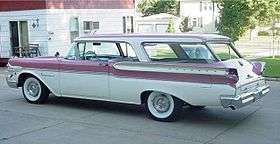
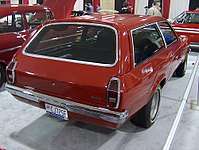
The first two-door station wagon was the 1946 Willys Jeep Station Wagon.[52] Other early two-door station wagons were the 1951 Nash Rambler[53] and the 1954 Studebaker Conestoga.[54] In 1956, Studebaker introduced three new two-door wagons in Pelham, Parkview, and Pinehurst trims.[55]
General Motors began producing two-door station wagons in 1955 with the "Chevrolet Handyman" and the "Pontiac Chieftan".[56] General Motors also introduced the sportier Chevrolet Nomad and Pontiac Safari to their lineup in 1955. Ford began production of steel-bodied two-door station wagons in 1952 with the Ford Ranch Wagon. In 1956 Ford responded to the Nomad and Safari with its own sporty two-door wagon, The Ford Parklane. The Parklane was a one-year only model, succeeded by the Ford Del Rio in 1957.
After the merger of Nash and Hudson, the new company, American Motors (AMC) reintroduced the two-door wagon in the "new" Rambler American line in 1958.[57] It was "recycling" with only a few modifications from the original version and targeted buyers looking for "no-frills" economy.[58] American Motors' strategy of reintroducing an old design made for two distinct model runs, one of few examples where such a strategy has been successful for an automobile manufacturer.[59]
The Chevrolet Vega Kammback, introduced in September 1970, was the first U.S.-made four-seat wagon and the first two-door wagon from GM in six years. It shared its wheelbase and length with Vega coupe versions and was produced in the 1971–1977 model years.
The last two-door wagon available in America, the Volkswagen Fox, was discontinued in 1991.
United Kingdom
1930s to 1960s
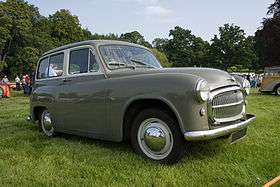
Early estate cars were after-market conversions, with the new bodywork using a wooden frame and either steel or wooden panels. These wooden-bodied cars, produced until the 1960s, were amongst the most expensive vehicles at the time. Since the 1930s, the term shooting-brake (originally a term for hunting vehicles) has been an alternative, if now rarely used, term for estate cars in the UK.
Later estate cars were produced by vehicle manufacturers and include the 1937 Commer (based on the Hillman Minx Magnificent),[60] 1952 Morris Minor Traveller, 1952 Morris Oxford Traveller, 1954 Hillman Husky, 1954 Austin A30 Countryman and 1955 Ford Squire. The majority of these models were two-door wagons and several models were built on the chassis of relatively small cars.
Manufacturers often chose a specific model name to apply to all their estate cars as a marketing exercise — for example Austin used the Countryman name and Morris estates were called Travellers. Some estates were closely derived from existing commercial van models, such as the Austin A30/35 Countryman and the Hillman Husky. Others, such as the Morris Travellers, the Austin Cambridge Countryman and the Standard Ten Companion were bespoke.
Rover and Austin produced 4×4 canvas-topped utility vehicles in the 1950s that were available in estate car body styles that were sold as "Station Wagons". They incorporated better seating and trim than standard editions with options such as heaters. Early advertising for the Land Rover version took the name literally, showing the vehicle collecting people and goods from a railway station.
Despite the popularity of station wagons in America, station wagon offerings in the U.K. from Ford and Vauxhall were limited to factory-approved aftermarket conversions of the Ford Consul and Vauxhall Cresta, until the factory-built Vauxhall Victor wagon was introduced in 1958.
1960s to present
.jpg)
One of the smallest estate cars ever made was the Morris Mini Traveller / Austin Mini Countryman, introduced in 1960.
Ford's first factory-built wagon was the 1963 Ford Cortina.
The 1967 Hillman Husky station wagon version of the Hillman Imp was unusual in being a rear-engined estate car.
Ford and Vauxhall produced factory-built estate variants of all three of their respective core models (small-, mid- and large-size cars) by the 1970s. The FD- and FE-Series Vauxhall Victors, built between 1966–78, were very large cars by British standards and featured estate models in the style of an American station wagon with front and rear bench seats and large-capacity petrol engines.
Other estate cars sold in the United Kingdom included the Morris 1100 (introduced in 1966), Vauxhall Viva (introduced 1967), Ford Escort (introduced in 1968) and Vauxhall Chevette (introduced 1976).
Germany
_Avantgarde_station_wagon_(2015-07-09)_01.jpg)
Germany is the largest market for station wagons and estate cars in the world, with some 600–700,000 vehicles sold each year - amounting to 20% of all car sales.[61] German-designed station wagons and estates are currently produced by Audi, BMW, Mercedes-Benz and Volkswagen. Some larger estate models are available with a third row of seats, such as the rear-facing jump seat for two passengers in the cargo area of the Mercedes-Benz E-Class wagon.[62]
In 1961, Volkswagen introduced the two-door "Variant" body style of the Volkswagen Type 3 (also known as the Volkswagen 1500 - later the Volkswagen 1600). The Type 3's rear-engine layout was retained for the estate models, but the engine profile was flattened, resulting in a small car offering interior room, as well as trunk space in the front. The model was offered through the 1973 model year.
Estates produced in East Germany include the 1956–1965 Wartburg 311/312/313, the 1963–1990 Trabant 601 Universal and the 1966–1988 Wartburg 353 Tourist.
France
.jpg)
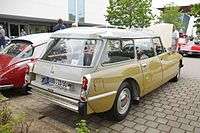
In France, almost all station wagon / estate models are called a "Break", although the spelling is different to the English shooting brake.
The first estate produced by a French manufacturer was the Citroën Traction Avant Familiale model introduced in 1935.[63] The first Peugeot station wagon was the Peugeot 203, introduced in 1950.[64]
In 1958, the Citroën ID Break (known as the Safari in English-speaking countries) was introduced, being larger than other French estate models and of similar size to the contemporary full-size station wagons from the United States. It had a seating capacity of eight people, consisting of two front-facing bench seats and two folding inward-facing seats in the cargo area. The 'Familiale' version had a front bench seat, a forward-facing three-space bench seat in the middle and a folding forward-facing three-seat bench in the rear, providing a versatile nine-seat car. The Citroën ID also had a two-part tailgate and hydropneumatic suspension, which allowed a self-levelling ride-height and automatic brake biasing regardless of the load carried. The car could also 'kneel' to the ground for easy loading of heavy or large items. The successors to the ID, the Citroën CX and Citroën XM continued to be amongst the largest estate cars produced in Europe, but the model was discontinued in 2000 and an estate version was not available for its Citroën C6 successor.
The Peugeot 404, introduced in 1960, offered a conventional alternative to the innovative Citroëns for buyers wanting a large estate car. Its replacement, the 505 was available in both five-seat and seven-seat 'Familiale' versions. As with the Citroëns, changing demands in the French car market led to the end of the large Peugeot estate models in the mid-1990s, with the smaller Peugeot 406 becoming the largest estate model in the range from 1995. In a similar situation to the United States, the decline of traditional Break and Familiale models in France was in no small part due to the introduction of the minivan in the form of the Renault Espace in 1984.
Sweden
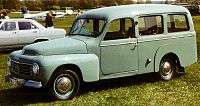
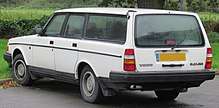
The first station wagon / estate produced in Sweden was the Volvo Duett, introduced in 1953.[65] The Duett two-door wagon was conceived as a dual-function delivery van and people-carrier, and is based on the chassis of the PV444 and PV544 sedans.
Saab began producing estates in 1959, in the form of the Saab 95 two-door wagon, which was based on the Saab 93 sedan.[66]
In 1962, the Volvo Duett was replaced by larger Amazon, which has a four-door body and a horizontal split tailgate. Volvo continued production of station wagons through the Volvo 145 (introduced in 1967), then the Volvo 200 Series (introduced in 1974) and the Volvo 700 Series (introduced in 1985). In many markets, the station wagon models of the 700 Series significantly outsold the sedan models. In 1990, the 700 Series was replaced by the Volvo 900 Series, which was sold alongside the smaller Volvo 850 wagon that was introduced one year later. The 900 Series ended production in 1998 and its successor (the Volvo S80) did not include any wagon models. Volvo station wagons produced since the mid 1990s are the Volvo V40, Volvo V50, Volvo V60, Volvo V70 and Volvo V90, with the V40 and V90 models currently in production.[65]
Saab — following a hiatus in estate production since the Saab 95 ended production in 1978 — introduced the four-door Saab 9-5 estate in 1997, which was produced until 2010.[67]
Switzerland
In 1983, estates represented 15% of the passenger car market,[68] reflecting a trend throughout Europe of increasing popularity through the 1980s, with the vehicles becoming less cargo-oriented.
Japan
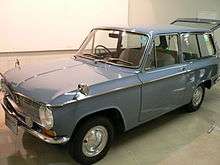
The first Japanese station wagon was the 1969 Isuzu Bellel four-door wagon, based on a compact sedan chassis. This was followed by the 1963 Mazda Familia, 1966 Toyota Corolla, 1967 Isuzu Florian, 1969 Mitsubishi Galant, 1973 Mitsubishi Lancer and 1974 Honda Civic wagons. However, Japanese manufacturers did not build station wagons in large volume until recently.
Models marketed as passenger station wagons in export markets were often sold as utilitarian "van" models in the home market. Some were not updated for consecutive generations in a model's life in Japan, for example a sedan might have a model life of four years but the wagon was not updated for up to eight years (such as the Toyota Corolla wagon built from 1979-1987) and the 1987-1996 Mazda Capella wagon). Station wagons remain popular in Japan, although they are in slow decline as the SUVs and minivans have taken over a large portion of this market.
Korea
South Korean manufacturers do not have a strong tradition in producing estate cars. First estate car by the South Korean manufacturer was being released way back in 1995 as the Hyundai Avante Touring (Lantra Sportswagon), followed in early 1996 as the Kia Pride station wagon. Daewoo Motor followed suit a year later with the first-generation Nubira.
South Korean manufacturer Kia produce both the Cee'd and Optima estates designated as Sportswagons with sister company Hyundai offering estate versions of the i30 and i40.
Australia
_SS_Sportwagon_(18698844380).jpg)
The first Australian-designed car was built in 1948 but locally designed station wagons did not appear until nine years later, when the 1957 Holden FE was introduced. The Holden's main competitor, the Ford Falcon (XK) introduced wagon models in 1960.
Ford and Holden produced wagon models based on each generation of their large sedan platforms until 2010. Other wagons produced in Australia include the Toyota Camry and Mitsubishi Magna. The large Ford and Holden wagons were usually built on a longer wheelbase than their sedan counterparts, until the introduction of the Holden Commodore (VE) which switched to sharing the sedan's shorter wheelbase.
Ford ceased production of wagons in Australia when the Ford Falcon (BF) ended production in 2010, largely due to the declining station wagon and large car market, but also following the 2004 introduction and sales success of the Ford Territory SUV.[69] Production of wagons in Australia ceased altogether in 2017 when the Holden Commodore (VF) ended production.
Truck-Based Station Wagons
The Chevrolet Suburban that was released in 1935 began the history of "truck-based station wagons", these vehicles were built in the chassis of a pickup truck or a van.
References
- Hillier, Victor; Coombes, Peter (2004). Hillier's Fundamentals of Motor Vehicle Technology: Volume 1 (5th ed.). Nelson Thornes. p. 11. ISBN 978-0-7487-8082-2. Retrieved 15 January 2013.
The estate body, also known as station wagons in some countries, has the roofline extended to the rear of the body to enlarge its internal capacity. Folding the rear seats down gives a large floor area for the carriage of luggage or goods. Stronger suspension springs are fitted at the rear to support the extra load. Hatchback: ...as with the estate, the rear seats fold down to give a flat floor for the transportation of luggage or other objects. When the tailgate is closed, the luggage compartment is usually covered with a parcel shelf.
- Peck, Colin (2008). British Woodies: From the 1920s to the 1950s. Veloce Publishing. p. 5. Retrieved 14 November 2019.
- Street Rodder, 7/94, p.90 caption.
- Jazar, G. Nakhaie (2008). Vehicle Dynamics: Theory and Application. Springer-Verlag. pp. 30, 1.8.3 Passenger Car Body Styles. ISBN 978-0-387-74243-4. Retrieved 23 November 2010.
Hatchback: Hatchback cars are identified by a rear door including the back window, that opens to access a storage area that is not separated from the rest of the passenger compartment. A hatchback may have two or four doors and two or four seats. They are also called three-door or five-door cars. A hatchback car is referred to a liftback when the opening area is very sloped and is lifted up to open. Station Wagon: A station wagon or wagon is a car with a full-height body all the way to the rear; the load carrying space created is accessed via a rear door or doors.
- Erjavec, Jack (2004). Automotive Technology: a Systems Approach Chapter 4,. Cengage Learning. p. 55, Body Styles. ISBN 978-1-4018-4831-6. Retrieved 23 November 2010.
Liftback or Hatchback: The distinguishing feature of this vehicle is its luggage compartment, which is an extension of the passenger compartment. Access to the luggage compartment is gained through an upward opening hatch-type door. A car of this design can be a three- or five-door model; the third or fifth door is the rear hatch. Station Wagon: A station wagon is characterized by its roof which extends straight back, allowing a spacious interior luggage compartment in the rear. The rear door, which can be opened numerous ways depending on the model, provides access to the luggage compartment. Station wagons come in two and four-door models and have space for up to nine passengers.
- "Car Design Glossary - Part 2: One-Box (Monospace or Monovolume)". Car Design News. Retrieved 23 November 2010.
A three or five-door hatchback (no separate trunk compartment) is a 'two-box' car.
- Mike Mueller (2003). American Cars of the '50s. Crestline Imprints. ISBN 0-7603-1712-7.
- Mueller, Mike (2003). American Cars of the '50s. MBI Publishing. ISBN 978-0-7603-1712-9.
- "Definition: Station Wagon". American Heritage Dictionary. Retrieved 13 January 2013.
- Neil, Dan (28 April 2002). "The Hatchback Is Back (but Nobody Uses the H-Word)". The New York Times. Retrieved 23 November 2010.
- Hartford, Bill (February 1969). "Sizing up the 1969 Station Wagons". Popular Mechanics: 106. Retrieved 23 November 2010.
- "The Thinker (Detroit Style)". Time. April 21, 1967. Retrieved 10 October 2015.
- Norbye, Jan P.; Dunne, Jim (October 1970). "The '71 Wagons, Big Changes Coming Up". Popular Science: 74–75. Retrieved 10 October 2015.
- Byard, RW; Bourne, AJ; James, R (August 1999). "Childhood deaths and cargo barriers in cars". Journal of Paediatrics and Child Health. U.S. National Library of Medicine. 35 (4): 409–10. doi:10.1046/j.1440-1754.1999.00379.x. PMID 10457305.
- "How Porsche Helped Audi Create the World's First Performance Wagon". www.roadandtrack.com. 12 July 2017. Retrieved 26 March 2020.
- "Grand Sports". www.aus-ford-uk.co.uk. Retrieved 28 March 2020.
- "The World's Best Station Wagons - Gear Patrol". www.gearpatrol.com. 17 August 2015. Retrieved 27 November 2018.
- "Is this Super Rare BMW M5 Wagon Worth $130,000?". www.roadandtrack.com. 3 August 2017. Retrieved 27 November 2018.
- "E61 BMW M5 Touring: One of the best M cars of all time". www.bmwblog.com. 22 January 2016. Retrieved 27 November 2018.
- "A Short History of Station Wagons in the USA". www.stationwagon.com. Retrieved 4 November 2018.
- "The History Of The Station Wagon". www.coolridesonline.net. Retrieved 4 November 2018.
- Mort, Norm (2010). American Woodies 1928-1953. Veloce Publishing Limited. p. 10. ISBN 978-1-845842-69-7. Retrieved 2017-05-12.
- "The Last, Great, Gasp of the American Station Wagon". theatlantic.com. Retrieved 4 November 2018.
- "1923 Star Station Wagon". The Henry Ford. Retrieved 2 August 2019.
- Lamm, Michael; Holls, Dave (1996). A century of automotive style: 100 years of American car design. Lamm-Morada. p. 29. ISBN 9780932128072. Retrieved 30 June 2012.
- G.N. Georgano, G. N. (2002). Cars: Early and Vintage, 1886–1930. Mason Crest. ISBN 978-1-59084-491-5.
- Narus, Donald J. (1977). The Great American Woodies and Wagons. Crestline Publications. ISBN 978-0-912612-13-3.
- Brown, Arch (April 1997). "Natural History: The 'Woody' Station Wagon Story — Part I". Collectible Automobile. 13 (6): 26–41.
- Vance, Bill (24 March 2001). "Motoring Memories: The history of the station wagon". Autos Canada. Retrieved 15 January 2013.
- Cawthon, Bill (15 May 2002). "Jeep: From Station Wagon to Superstar". Retrieved 15 January 2013.
- Editors of Publications International (13 December 2007). "1945–1952 Jeep: Willys Postwar Jeep". auto.howstuffworks.com. Retrieved 15 January 2013.CS1 maint: extra text: authors list (link)
- Collector Car Market Review (1999). "Postwar Station Wagons: Mom's Car Makes a Comeback". VMR International. Retrieved 15 January 2013.
- Schuon, Marshall (21 June 1992). "About Cars; Chewing Over the Art Of Automotive Design". The New York Times. Retrieved 15 January 2013.
- Lorio, Joe (27 November 2009). "The Wagon of Cadillacs". The New York Times. Retrieved 7 March 2012.
- Heaps, Russ (7 November 2003). "Europe's station wagons flourish - The Washington Times". Questia Online Library. Retrieved 15 January 2013.
- An, Feng; Sauer, Amanda (December 2004). "Comparison of passenger vehicle economy and greenhouse gas emission standards around the world" (PDF). Pew Center on Global Climate Change. Archived from the original (PDF) on 2016-10-31. Retrieved 15 January 2013.
- Taylor III, Alex. "The death of the station wagon". autos.yahoo.com. Archived from the original on September 29, 2011. Retrieved 7 March 2012.
- "BMW Might Kill 5 Series Wagon in Favor of GT Crossover". Edmunds.com. 2009-07-08. Archived from the original on August 30, 2009. Retrieved 2009-09-27.
- "2010 Cadillac CTS Sport Wagon 3.6". www.caranddriver.com. Retrieved 12 November 2018.
- "2014 Cadillac CTS-V Wagon First Test". www.motortrend.com. Retrieved 12 November 2018.
- "Toyota's own hybrid models are eating away at Prius sales". Autoblog. Retrieved 2020-07-09.
- http://www.vw.com/models/golf-sportwagen/?cid=ssem_MHm7hLRR_66236130786_c
- "Volkswagen Is Ending Golf Sportwagen Alltrack Production". blog.caranddriver.com. Retrieved 2019-08-10.
- "2018 Volvo V90 Wagon Will Be Custom Order Only in America". blog.caranddriver.com. Retrieved 2017-01-08.
- "Against the Grain: 21 Woodies That Weren't Station Wagons". Car and Driver. Retrieved 19 June 2017.
- Litwin, Matthew (September 2009). "DI-NOC Siding: Restoring a station wagon's wood grain is now quick and easy". Hemmings. Retrieved 19 June 2017.
- Auto Editors of Consumer Guide (9 October 2007). "1950–1959 Ford Country Squire". howstuffworks com. Retrieved 6 August 2010.
- "1955 Ford Country Squire Station Wagon". National Museum of American History. Retrieved 15 January 2013.
- Garrett, Jerry (9 September 2015). "Jeep's Wagoneer Making Fake Wood Grain Fashionable Again?". Garrett on the Road. Retrieved 19 June 2017.
- Sean (15 June 2015). "A look back at the 1963 – 1991 Jeep Wagoneer: A guide to year-to-year changes". Classic Cars Today Online. Archived from the original on 2017-07-08. Retrieved 19 June 2017.
- "2013 Mercedes-Benz GL450 vs. 2012 Mercedes-Benz E350 4Matic Wagon". www.motortrend.com. Retrieved 18 November 2018.
- "Automotive History: The Short And Odd Life Of The Two Door Station Wagon". www.curbsideclassic.com. Retrieved 25 February 2018.
- Severson, Aaron (19 September 2009). "Fashionably Small: The Compact Nash Rambler". Ate Up With Motor. Retrieved 27 February 2018.
- Gunnell, John (2004). Standard Guide to 1950s American Cars. Krause Publications. p. 235. ISBN 9780873498685. Retrieved 27 February 2018.
1954 Studebaker Conestoga two-door station wagon.
- Flory Jr., J. "Kelly" (2008). American Cars, 1946–1959: Every Model, Year by Year. McFarland. p. 700. ISBN 9780786452309. Retrieved 27 February 2018.
- the Auto Editors of Consumer Guide (25 October 2007). "1955-1957 Pontiac Star Chief Safari". HowStuffWorks. Retrieved 27 February 2018.
- McNessor, Mike (July 2011). "1958-'60 Rambler American". www.hemmings.com. Hemmings Motor News. Retrieved 27 February 2018.
- Mattar, George (October 2007). "1958-1960 Rambler American". Hemmings Classic Car. Retrieved 27 February 2018.
- Vance, Bill (28 July 2006). "Motoring Memories: AMC Rambler American 1958-1960". Autos Canada. Retrieved 27 February 2018.
- "Improved Commer 8-cwt. Van". www.commercialmotor.com. Retrieved 26 November 2018.
- Deutschland einig Kombiland
- "2013 Mercedes-Benz GL450 vs. 2012 Mercedes-Benz E350 4Matic Wagon". www.motortrend.com. Retrieved 27 November 2018.
- "A Short History of the Citroen Traction Avant". www.traction.ch. Retrieved 28 November 2018.
- "The World's Greatest Wagons: Peugeot 203, 403, 404, 504, 505 – An Illustrated History". www.curbsideclassic.com. Retrieved 28 November 2018.
- "Volvo Celebrates 60 Years of Station Wagon History". www.cheatsheet.com. 14 February 2016. Retrieved 30 November 2018.
- "Curbside Classic: 1970 Saab 95 – Saab Shows Ford How To Make The Shortest Three-Row Wagon". www.curbsideclassic.com. Retrieved 30 November 2018.
- "Saab 9-5 Model Details". www.nadaguides.com. Retrieved 30 November 2018.
- Meurer, Stany (1985-01-24). "Deux levres pour un hayon" [Two lips for one boot]. Le Moniteur de l'Automobile (in French). Brussels, Belgium: Editions Auto-Magazine. 36 (813): 25.
- Ford Falcon wagon dead, Drive.com.au, March 24, 2010
External links
| Wikimedia Commons has media related to Station wagons. |

.jpg)
